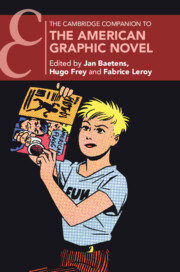Book contents
- The Cambridge Companion to the American Graphic Novel
- The Cambridge Companion to the American Graphic Novel
- Copyright page
- Contents
- Figures
- Contributors
- Editors’ Acknowledgments
- Introduction
- Part I History and Genre
- Part II Graphic Novels and the Quest for an American Diversity
- Index
- Cambridge Companions To …
- References
Introduction
What Is the American Graphic Novel?
Published online by Cambridge University Press: 10 January 2024
- The Cambridge Companion to the American Graphic Novel
- The Cambridge Companion to the American Graphic Novel
- Copyright page
- Contents
- Figures
- Contributors
- Editors’ Acknowledgments
- Introduction
- Part I History and Genre
- Part II Graphic Novels and the Quest for an American Diversity
- Index
- Cambridge Companions To …
- References
Summary
The Cambridge Companion to the American Graphic Novel provides students and scholars with a state-of-the-art collection of essays from experts in the field who are working on contemporary publications as well as the history of the medium. Through the pages of this book, they provide a series of new and original readings of the graphic novel. By focusing attention exclusively on the “American graphic novel,” one is able to explore critically and in depth how – since at least the 1970s – writers and artists have worked to provide a range of new content and style of cartooning to tell long-length stories, conduct journalism, interpret history, narrate autobiography, and develop original works of fiction. Graphic novelists and their work are today an established and important part of the cultural-literary landscape; they are honored by prestigious literary prizes, as well as play a part in mirroring American society back to their readers. Here, one thinks immediately of Art Spiegelman’s In the Shadow of No Towers (2004), dedicated to the 9/11 attacks and the American response thereto, which was selected as one of the ten most important works on the subject at the time of the tenth anniversary of the atrocity. Equally noteworthy are Alison Bechdel’s ground-breaking analyses of gay and lesbian experiences in times of changing values and attitudes in her memoir Fun Home (2006), and through her subsequent Are You My Mother? (2012) and The Secret of Superhuman Strength (2021). Just as important, and different again, are examples of works from Asian American and African American graphic novelists that offer autobiographical narratives on their specific lives and historical circumstances: to note one recent example, Thi Bui’s The Best We Could Do (2017) is a remarkable personal testimony on the history of America and Vietnam and the migrant experience of the author and her family. So, if American comics are filled with action-packed genre materials that provide excitement and spectacle, then one can equally generalize to say that the American graphic novel, in all its diverse forms, is proving to be a sounding board for highly personal, democratic, identity-based, and informed, often autobiographically slanted, representations of the state of the nation. The graphic novel (supported by mainstream corporate literary-oriented publishers, such as Abrams, Pantheon, and Penguin Random House) has developed to provide a key cultural space for broadly liberal values to be espoused through sometimes complex, sometimes deliberately simple, text and image, panel grids, and page layouts. While this is a still relatively young form of graphic narrative, one can say that in the last forty years, it has become more and more important for American literature per se. There is no longer any need to assert the genre’s legitimacy or spend pages defending the choice to study our subject.
- Type
- Chapter
- Information
- Publisher: Cambridge University PressPrint publication year: 2023



